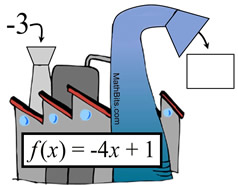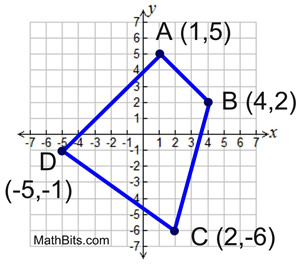|
Directions: Read carefully.
1. |
A function machine is shown at the right.
If -3 is input for this function, which choice will be the output?
Choose:
|
 |
|
2. |
A function machine is shown at the right. If the output for this function is -16, which choice was the input value?
Choose:
|

|
|
3. |
A transformation function machine is shown at the right. If point P(2,-5) is input for this function, which choice will be the output (the image)?
|
|
| Choose:
|
|
4. |
A transformation function machine is shown at the right. If image M' (-4,2) is the output from this function, which choice were the coordinates of the pre-image (the input)?
|
|
|
|
5. |
A translation function is given to be
(x, y) → (x - 5, y + 8).
a) If A(-1,-5), what are the coordinates of A' under this translation?
Choose:
b) If B' (6,-2), what are the coordinates of B under this translation?
Choose:
|
|
|
6. |
Under a transformation, A (1,6), B (7,-2), and
C (4,-5) become A' (4,5), B' (10,-3), and
C' (7,-6). Which choice is a possible rule for this transformation function?
Choose:
|
|
|
7. |
The quadrilateral seen at the right will be input into a transformation machine that will rotate the quadrilateral counterclockwise 90º.
a) Which rule will be used by the transformation machine?
Choose:
|
 |
|
b) What will be the coordinates of the output (the image)?
Choose: |
|
8. |
A transformation function takes the line segment from point A(5,2) to point B(-3,4) as input. The function rule (x, y) → (y, x) is applied to the segment.
Which of the choices is the output of the endpoints of the segment?
Choose:
|
|
|
9. |
Which of the following transformation function rules will not produce a rigid transformation?
|
|
|
10. |
Which of the following transformation functions produces the same result as a point reflection in the origin?
|
|
|

NOTE: The re-posting of materials (in part or whole) from this site to the Internet
is copyright violation
and is not considered "fair use" for educators. Please read the "Terms of Use". |
|